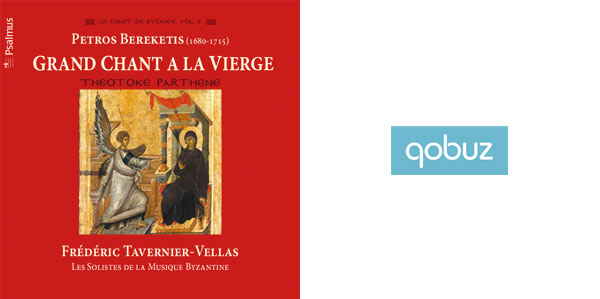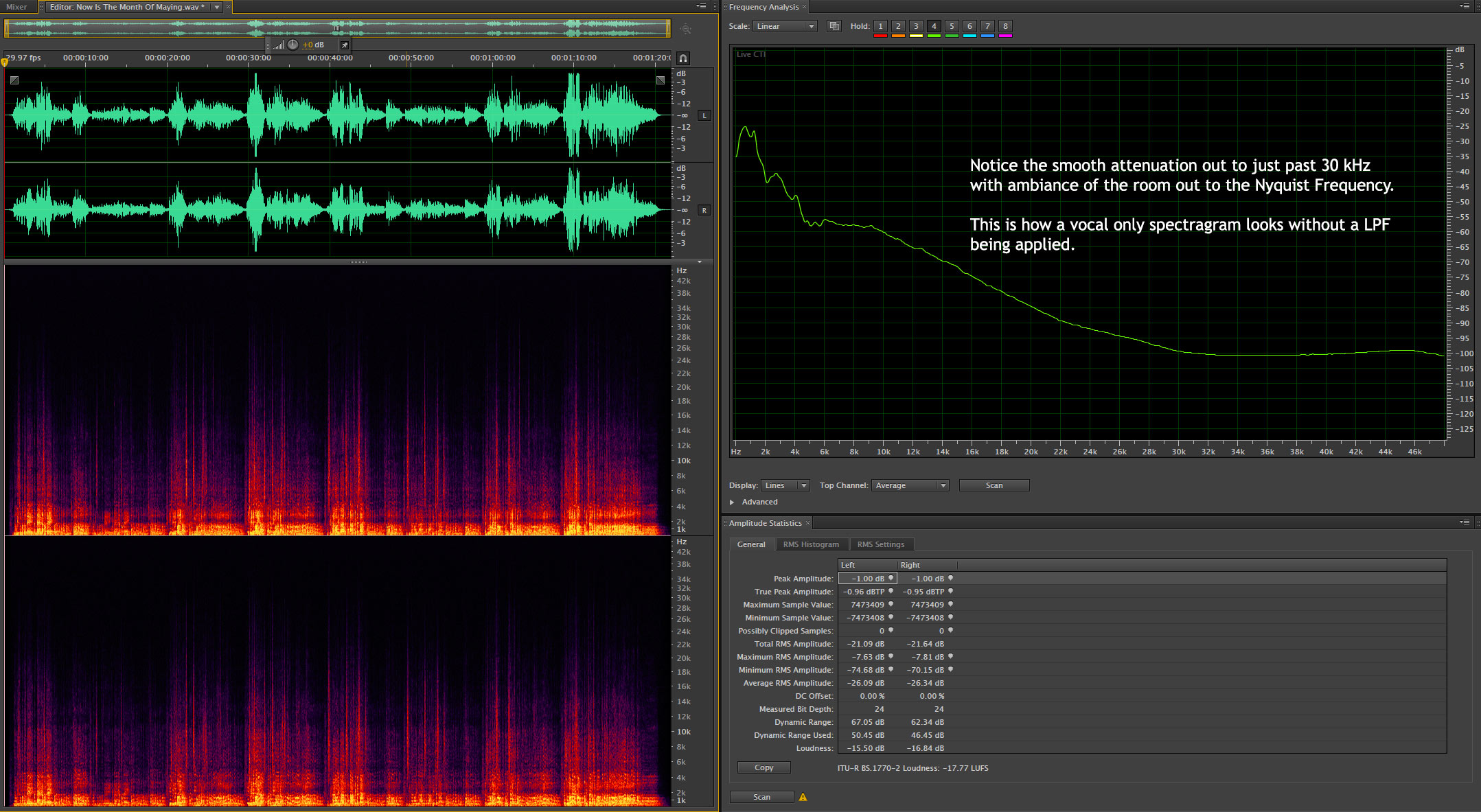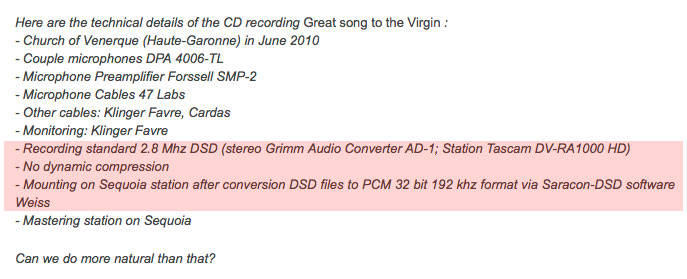Qobuz Responds
Normally, I wouldn’t post statements made by individual producers of recordings that I’ve investigated, evaluated, tested and discussed in one of my posts…but it seems a member of Qobuz (the French download site) lifted my entire article (you can read it at here) from January 27th and posted it on a Qobuz forum. Given that the article shows a couple of downloaded tracks claiming to be high-resolution are actually misidentified as such, the site contacted the producers of the recordings for their reaction. This makes it worth re-posting their positions here.
Before I continue I feel obligated to state the following. It takes a lifetime of experience, a willingness to share my knowledge and opinions and a substantial amount of time to post a daily blog post. And although I’ve seen it done before, I’m discouraged that the Qobuz site would allow someone to “reprint” my entire article with the associated graphics on their site without my permission. I would have expected them to link to my post and add any comments locally.
The post on the French site says, “Hello, not finding your site the ideal place to post a response to the particularly sensitive issue of the quality of high-resolution files…”. That’s a cop out…they basically appropriated my post without permission. I have requested that they remove it and simply link to RealHD-Audio.com.
The Qobuz site is a French site. I know enough French to be dangerous but I did use the Google translator to read the statements from the producers of the two recordings in question. So the words are Googles translation and not the actual words of these gentlemen.
The first comes from Jean-Marc from Psalmus Records, the producer of the “Great Song to the Virgin (PSAL013). If you go back and look at the spectragram I created using Audition, you’ll clearly see that it tops out at 23 kHz. And I did acknowledge that human voices are not going to contain much information in the ultrasonic range. But this is a CD-Quality recording and definitely does not qualify for the High-Resolution name. Jean-Marc response actually confirms this.
You can go to the Qobuz site and read the translation of the responses (Here’s the link).
The essence of his message is that I’m confusing the “technically achievable sound spectrum thanks to high definition formats and the actual sound spectrum of musical instruments and voices”. There’s no confusion here…at least on my part. I know the frequency response of the human voice and instruments. But even considering those realities, why would Qobuz sell/provide a file that is only as good as a CD in a bit bucket that extends to 96 kHz (the sample rate is 192 kHz)? A more straightforward scheme would be to acknowledge that this particular recording doesn’t need the 192 kHz/24-bit sample rate and provide it at 48 kHz/24-bits. Why ask your members to download a file that has mostly zeros? And you certainly wouldn’t provide it as a demonstration of how good things can get in high-resolution.
Just so that you can view a vocal recording that isn’t rolled off…here’s a spectragram of my Zephyr: Voices Unbound project from many years ago.
Figure 1 – The spectragram of an a capella vocal track at 96 kHz/24-bits from AIX Records. There is no Low Pass Filtering and actual sound up to about 30 kHz [Click to enlarge].
This is what a real high-resolution audio track looks like…even one that contains only voices. There is no roll off suddenly at 23 kHz!
He goes on to talk about other projects with greater frequency response and then begins talking tech. And it’s apparent that Psalmus is a DSD shop that uses DXD to do their production work. Here’s the tech notes associated with the recording in question:
Figure 2 – The head of Psalmus provided the technical details associated with their Qobuz release at 192 kHz-24 bit PCM [Click to enlarge].
The technical details from Jean-Marc reveal the truth behind this recording. And it yet another example of why buyers of so-called “studio masters” or “high-resolution” audio files should do their homework. Look at the highlighted items in the list. This is DSD 64 recording, which means that it will deliver great “in band” sound up to around 25 kHz before the much-discussed ultrasonic noise becomes a factor. This is simply part of the DSD encoding scheme…and the way that people get rid of it is to use a Low Pass Filter…in this case at 23 kHz. If I were required to record a project using DSD 64, I would do the same thing. But I wouldn’t call it a high-resolution audio track.
Then what did Psalmus Records do? They used a software converter (the very good Saracon made by Weiss Engineering) to turn their DSD 64 file into a 192 kHz/32 bit PCM file. Does upconverting a “standard resolution” audio recording to 192 kHz/32-bits elevate the fidelity of the source? Absolutely not…as the spectragram clearly shows. There is nothing above 23 kHz. The fidelity of this recording is standard resolution. In our new lexicon of terminology it would be a Standard Definition Recording, High-Resolution Post Production and High-Resolution Distribution.
And maybe it doesn’t matter. The recording sounds really good. But the last line of the note from Jean-Marc says, “Can we do more natural than that?” Well as a matter of fact, you can. Here’s a few thought that come to mind:
• Avoid DSD and record in a format that will give you accurate dynamic and ultrasonic frequency response without the noise.
• Don’t put a 1-bit DSD 64 recording into a 192 kHz/32-bit PCM container…it does nothing for the fidelity of the tracks.
• Don’t make a CD-Quality recording and then market it as something that it’s not…just stay with CD fidelity and everything would be on the up and up. There’s nothing wrong with recording and releasing CDs. Your recording sound great just the way it is.
• Don’t apply a Low Pass Filter, it just means you’re trying to hide something.
I’ve written too much today. I’ll go through the response regarding the other track tomorrow.
NOTE: A co-founder of Qobuz tweeted to me and called my post “malicious”. Nothing could be further from the truth. My intent with these posts is to inform. If there’s something that I’ve said that is incorrect, I will correct it and offer my apology. So far I’ve not found anything in my post about these tracks that needs correcting.




Yes indeed – nothing malicious about your posts at all, and many of us are grateful for your courage in standing up for transparency within the whole discussion of hi-rez sound, so much of which is dominated by vested interests. I’ve been a regular reader of your blog for about half a year and just wanted to say thanks!
Thanks Chris. Rather than my evaluation of their tracks being taken as an opportunity to think again about the marketplace…they chose to call the piece malicious and state that I must be jealous to write about qobuz in the way that I did.
Mark,
It must be noticed that a reader of Qobuz familiar with your site sent us as a letter his translation of your original post and that we answered to him as we do every week part of our weekly newsletter. We did’nt reproduce your article in english and we did’nt reproduce either your graphics – but we did put a link to your article which is fair enough.
We have the feeling that only the recordings you are doing by yourself seems to comply with your idea of H D Audio. And that the music of Beethoven, Palestrina and a few others are not likely to be interesting for you if they are not able to fulfill the entire spectrum you are expecting for your graphics !
Clearly we are as far as we are concerned in the music business – not in the audio business.
But we have at the office two quite serious engineers full-time only for the sound, not speaking about the engineers who are working from the beginning on those problems since we began our service in 2008 – they know a little about those subjects. And on top of that all the serious professionals who are delivering us with their work are most often customers of Qobuz. None of them never complain ) to the contrary they are totally supportive with our work.
This will be my last word here – in French (Google Translation needed !) :
Ne seriez-vous pas “plus Royaliste que le Roi” ?
Le Roi étant en l’occurrence ces professionnels qui partout dans tous les studios sur terre chaque jour réalisent en conscience les enregistrements qui nous nourrissent notre goût pour la musique ?
Thanks for responding, I must say I do appreciate it. I’m not sure I agree that reproducing a translation of my entire article makes any difference as to whether it violates copyright issues. I would ask that you remove the translation of my post and refer individuals to the source…as I did with your discussion. The spectragram that accompanies the article is still being served by your server…so I’m not sure how you can claim you didn’t reproduce it.
There are quite a few engineers and companies producing real high-resolution recordings…2L from Norway does and excellent job and Linn in GB. It’s not whether I find the music of Beethoven, Palestrina or Ludwig Senfl interesting or not (my Ph.D. is in music composition…I do know about the history and literature of music)…it’s whether a recording of any work is accurately described and promoted. I’m very content with my CDs and my small collection of vinyl LPs. But in a new market such as high-resolution audio, it seems to me that promoting a CD-Quality project as an example of how great 192 kHz sampling rates can be is confusing at the least.
I’m in the music business as well and I am the engineer that produces, mixes and masters the products that are found on my label. There are certainly going to be differences of opinion on formats and fidelity. I stand by my assessment of the tracks that I downloaded and I will continue to advocate for truth in advertising. It would be great if qobuz would more rigorously evaluate the tracks it sells.
While there are certainly producers of high resolution audio in the digital music industry that intentionally provide a high container than the music deserves, in this case, I think the disagreement over whether these files should be classified as “high-resolution” is more telling about the lack of a clear definition of what “is” or “is not” high resolution.This makes Mark’s recent posts very topical for this post as well.
I also think it highlights why DSD always gets caught in the middle of this discussion. Specifically, it seems to me (from a non-expert in point of view) that if we take the very literal definition of “resolution”, at least relating to a technical field, then broadly we can say resolution is “the ability to distinguish between two measurements”. In the world of audio recording and playback, this definition seems most related to the sampling rate of a recording. The greater the sample rate, the greater the potential resolution, i.e. greater ability to distinguish two neighboring frequencies. For sake of argument, I’m making assumption that sampling rates above Redbook audio are considered high resolution. So by this definition and assumption, I could see how the high sampling rate used in DSD could indeed allow for a high resolution, despite the lack of ultrasonics in the final spectragram. Moreover, by this definition, this is also an argument for why any analog recording could be considered high resolution, as along as the ADC was performed at sufficient sampling rate.
However in practice, this definition has a huge potential disadvantage for the consumer, because it takes significance away from the actual fidelity of the original recording, the ability to faithful capture all aspects of the original sound produced by the artists, which arguably one of the most important aspects. By using only a specific definition of resolution, it means there is greater unknown in the actual fidelity of a recording sold as “high” resolution recordings, especially when provenance is not stated.
So perhaps the real fault here is with the term high-resolution itself? I consider Mark (and others) definition of “high resolution” held to a very high standard. Not that that’s a bad thing, and in fact is why I enjoy and have purchased Mark’s recordings, and are more likely to purchase similar recordings in the future.
So perhaps the term “high fidelity” would be a more accurate label. This term incorporates all acoustic features into the definition, sampling rate, dynamic range, frequency space, filtering, etc. For me this term would clearly place only select audio recordings at the top of the fidelity scale. DSD would not meet the highest criteria, but would still fall above standard fidelity recordings (arbitrary of course, but say Redbook).
For me as a consumer, the requirement that I would insist on is that I want to know if DSD is used anywhere in the production chain, because then I am made aware that there is a trade-off in the absence in ultrasonic frequency space for increased sampling rate. It is up to the consumer to be educated about what this means for the ultimate quality, and whether this trade-off is worth their coin. I personally don’t feel the increased sampling frequency makes much difference based on my ears and audio system, so if given a choice, I will select the less expensive (and relatively smaller filesize) 96/24 PCM everytime. But of course others should be free to choose based on their system. This is why I appreciate Mark’s efforts to establish this forum because it has provided solid articles (e.g. John Siau’s interview) that give a counter point perspective for the use of different recording formats and allows consumers to make an informed decision on the content they are buying.
Todd, thanks for your thoughts. You’re right that the whole DSD thing comes back to cloud the picture. I seriously doubt that in the current climate that anything will improve with regards to opinions about formats and the definition of high-resolution audio.
So, is DSD64’s dynamic range approximately 20 bits or 120 db? If so, DSD64 could be considered higher in quality than a CD. Then again, HDCD is also 20 bits when decoded properly…
SACD or a DSD 64 encoded files can present the traditional “audio band: or 20-20 kHz at up to 120 dB or more very well. But as we’ve seen the production path up to the final delivery format doesn’t get to those specifications. DSD 64 was a reasonable thing to do back in 2000 but has no place in current high-resolution productions.